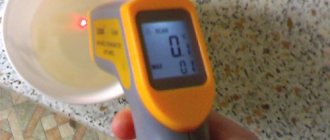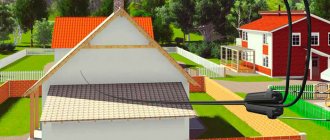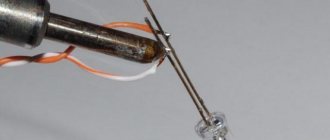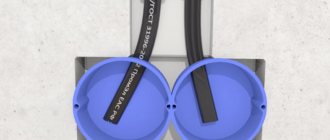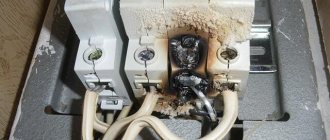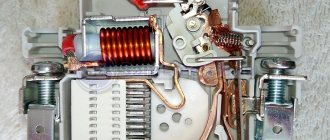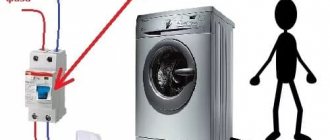Where is a pyrometer used?
However, its scope of application is not limited to these industries only. It is used to measure the temperature of moving parts of mechanisms. For example, to find out whether the bearing on the engine is heating up or not.
They detect temperature differences on adjacent surfaces - compressor cylinders in refrigeration units, or individual parts inside a car.
Let's say your engine is overheating for an unknown reason and you need to find out why. To do this, use a pyrometer to first measure the temperature at the outlet pipe of the thermostat and compare it with the temperature of the radiator.
If the difference is very large, then the thermostat is most likely to blame.
Another application is measuring the temperature of hot metal for its proper processing.
If you do this with classic thermometers, then you will lose precious time heating the thermocouple itself. And with a wireless thermored pyrometer, all this takes literally a moment.
Here is a summary graphical thumbnail and a breakdown of the capabilities and areas of application of pyrometers:
Decoding and features
How to use a pyrometer
After you buy such a device for measuring surface temperature, read the instructions in detail. Despite the fact that the operating rules are simple, incorrect actions can lead to significant distortions in temperature readings.
How to correctly determine what heating temperature a material has:
- The device must be turned on.
- Direct the bell to the surface to be measured.
- Separate the boundary of the measurement spot using a laser pointer.
- After the device is activated, the temperature value appears on the display. The values can be replaced by the following indicators or written to the device memory. It all depends on the chosen model.
Why the pyrometer is lying - reasons
This device is certainly good, but let’s take a closer look at the question of how to use it correctly. After all, simply pointing a laser beam and reading the readings on an electronic display does not always guarantee or give correct results.
There are many errors in measurements that most users are not even aware of. Measuring temperatures using an optical device differs from measuring temperature using contact devices.
Here are the main mistakes that beginners make:
- the material from which the measurement item is made is not taken into account
- measurements are taken through glass or in a dusty, damp room
- the temperature of the pyrometer itself differs significantly from the ambient temperature
- measurements take place too far from the object, without taking into account the cone of beam expansion
- thrifty “specialists” try to work with a device like a thermal imager over large areas, without taking into account the update frequency of the device’s readings
Let's consider all these points in more detail.
Are infrared thermometers safe?
New technologies often frighten people, including non-contact temperature meters. For example, many are interested in the question of what is the danger of IR thermometers and whether there is any.
Based on the design of these devices and the principle of their operation, it can be understood that an infrared thermometer does not pose any danger to humans and even to small children.
Safety in the use of non-contact thermometers is ensured by the device itself and its operating principle.
In rare cases, the plastic from which these gadgets are made may pose a potential danger, but even the cheapest material will not cause significant harm to health.
This is due to the fact that the device scans the surface of the human body, from which thermal radiation comes and is rarely used.
Important!
Thermal radiation comes from the person, and not from the device!
Thus, IR thermometers do not affect the body in any way, but only capture its heat, transform the received signal into electronic form, the result of which is displayed on the screen.
In addition, the safety of devices is stated in the instructions that come with each device model.
Hypothetically, the conditional danger may lie in the inaccuracy of measurements, which usually do not exceed 1-2 degrees Celsius.
This error is not critical, and therefore, by and large, even if it is present, there will be no harm from it.
To eliminate unreliable readings from the device, it should be periodically checked and calibrated.
Moreover, non-contact temperature measurement ensures the protection of healthy people.
When a healthy person does not touch a sick person, there is less risk of infection.
You can also take a small child's temperature while he sleeps so as not to disturb his sleep.
Beam reflection error and emissivity
When you measure degrees with a contact thermometer, you are in fact only measuring body temperature. But if you try to do the same thing at some distance, then you will simultaneously measure all those waves and rays that, regardless of your desire, somehow fall into the pyrometer lens.
And not only the radiation that the body emits gets there.
And if you don’t know how to set up the pyrometer correctly, then the device will show complete nonsense.
What kind of interference is this that affects the measurement accuracy? When working with a tool, 3 components fall into its lens:
- rays that the body passes through itself
- the rays it emits (this is its own temperature)
- reflected rays from surrounding objects
Transmitted rays are usually not taken into account in calculations, because most bodies are simply opaque to them. Therefore, only two quantities are taken into account:
- emissivity or emissivity factor
- reflection coefficient
Moreover, you should be more interested in the coefficient. radiation, since this is the very temperature that the body has.
The emission (radiation) coefficient is a value that shows what percentage of the total radiation is heat. The rest may be reflected light or light that passes through the body.
In this regard, it is worth noting that the pyrometer cannot measure the temperature of an object that is behind glass, in smoke or fog.
The glass for the optics of the device is not a transparent element, but a separate object that emits its own radiation. Therefore, it must be removed from the measurement area.
Most bodies and surfaces around us have an emissivity of 0.95. These are the factory settings that are initially set on the devices.
Moreover, on cheap models, they are hard-wired into the software component once and for all, and you cannot change them. On more expensive devices, this coefficient. can be adjusted manually.
Why is this necessary? For bodies of different composition and properties, coefficient. radiation is different. And the higher it is, the more accurate the temperature measurement results with a pyrometer will be.
For example, if it is K=0.95, then you only have 5% left for reflection. The error that these same 5% will introduce will be extremely small and can be neglected.
But the fact is that in practice, both in electricity and in heating, we are of little interest in objects with a high emissivity. These include walls, floors, table surfaces, pieces of furniture, etc.
Using a pyrometer, we primarily measure copper or aluminum contacts, radiators, pipes, chrome heated towel rails, etc.
All of them have a bright shiny surface, which introduces a significant error into the measurement data. There is a certain nuance to this.
Purpose, device and principle of operation
Infrared thermometers are designed to remotely measure the temperature of any object, which is why they are called non-contact.
The object can be any living being or inanimate object, either in a solid or liquid state.
The main purpose of non-contact thermometers is to measure the temperature of a person’s body; you can also use an IR thermometer to measure the temperature of soup, porridge, tea, juice, milk and other products before feeding, for example, a small child.
The non-contact thermometer device consists of:
- housings;
- optical system (sensor);
- sensor-converter;
- electronic converter;
- counting device;
- trigger (Start button);
- display and control panel.
Depending on the device, IR thermometer models may run on different batteries.
The principle of operation of an infrared thermometer is to measure the thermal radiation of the object under study to determine its temperature.
The optical system of the device is designed in such a way that the thermal radiation emanating from the measured object is focused and transmitted to the sensor-converter.
The converted electrical signal is proportional to the temperature value of the measured surface.
This signal is transformed in an electronic converter, after which it is displayed on the display in the form of specific numbers.
All these processes occur almost instantly, literally in a fraction of seconds.
As a result, the temperature of the measured object can be found out in one or two seconds, which is very convenient.
Difference in readings when measuring heated and cold bodies
For example, if your object has an ambient temperature, then it emits and reflects approximately the same temperature. But if it is heated, an error will immediately appear, significantly distorting the real data.
To verify all of the above, you can conduct a simple experiment yourself. Take a shiny pan and some book.
Next, take measurements on them with the same pyrometer. To increase the accuracy of the experiment, try to take measurements at one point.
Your results will definitely not be the same, although you won’t see much of a difference. If you double-check this matter with a contact thermometer, the deviations will be only 2-3 degrees.
But all this will be true only at room temperature of the objects. What happens if you pour hot water into a pan?
In this case, the measurements will immediately go wrong.
Hot pot temperature
Real temperature with correct coefficient
This suggests that the temperature of heated smooth shiny surfaces cannot be measured simply by a pyrometer.
Therefore, when videos show how easy it is to determine the temperature of batteries or contacts using a non-contact meter, do not trust this advertising too much.
Physical basis for the device of a non-contact thermometer
The distant year 1900 was the moment when scientific physicists managed to determine the complete electromagnetic spectrum. At the same time, qualitative and quantitative correlations describing infrared energy were established.
Definition of the term "black body"?
A radiation converter capable of absorbing all incoming radiation while completely eliminating the effect of any reflection or transmission of energy is characterized by scientists as a “black body”.
Design elements of a non-contact hand-held thermometer: 1 – button for setting temperature units (ºC / ºF); 2 – button for setting the operating mode; 3 – on/off button; 4 – measured temperature on the display; 5 – red laser dot; 6 – detection hole; 7 – measurement activation key; 8 – power supply
A “black body” is characterized by emitting maximum energy at each wavelength. In this case, the background level does not depend on the angular values. The “black body” is considered as the basis for understanding the physical principles of non-contact temperature control, as well as the technique for calibrating infrared non-contact thermometers.
The design of a hollow “black body” with a small hole in one of the end areas seems quite simple. If heating occurs to a certain temperature, a temperature balance is noted inside the hollow region. This temperature is radiated through the existing hole. For each temperature range and application, the material and geometric structure of the “black body” play a role.
If the hole has a very small diameter compared to the total volume, the interference of the ideal state is extremely small. By positioning the measuring device (non-contact thermometer) along the system hole of the “black body”, the measuring device is calibrated.
To calibrate devices such as a non-contact thermometer, special equipment is used, thanks to which a base temperature point is obtained and determined
In practice, simple devices use surfaces that are coated with pigmented paint, exhibiting absorption values plus emissivity for a specified range of wavelengths. This approach is sufficient for calibration under real control.
Black body background concept
Planck's law of radiant energy establishes the basic relationship for non-contact temperature measurement. This law characterizes the specific value of spectral radiation (Mλs) of a “black body” in the half-space region, taking into account temperature (T) and wavelength (λ).
An increase in temperature is accompanied by a shift in the specific maximum value of spectral radiation to the zone of shorter wavelengths. However, the presented formula cannot be used without restrictions. But it is permissible to take various relationships from the concept.
By introducing the spectral intensity of radiation for all wavelengths from 0 to infinity, the possibility of obtaining the background values of the object as a whole opens up. This relationship is determined by the Stefan-Boltzmann law:
M λ S = σ T4 [Watt m2] σ = 5.67 10–8 WM–2 K–4
The total background of the “black body” within the general range of wavelengths increases in proportion to the fourth power of the absolute temperature. Planck's law in the graph also demonstrates how the wavelength under the generation of the maximum of the “black body” background shifts due to temperature changes.
Wien's displacement law is derived from Planck's formula using the differentiation method:
λ max T = 2898 μm K
The wavelength at the maximum value of radiation, with increasing temperature, moves into the region of short waves.
What is a "gray body"?
Few bodies live up to the black body ideal. Many bodies emit much less radiation at the same temperature. Emissivity ( ε ) determines the ratio of the amount of radiation in real and “black” bodies (between zero and one). The infrared sensor perceives radiation from the surface of the object, including the ambient background, plus infrared radiation from the control object:
ε + ρ + τ = 1;
where: ε – emissivity, ρ – reflectivity, τ – degree of transparency.
Most existing bodies remain opaque in the infrared, so the following expression applies in such cases:
ε + ρ = 1;
demonstrating how much easier it is to measure reflection rather than the emissivity of an object (body).
Table of emissivity coefficients of different materials
In most cases, you can’t just point the beam, pull the trigger and immediately get the correct measurement result on the display. On shiny heated objects, all pyrometers begin to lie strongly.
And this error depends directly on the emissivity. Here is a detailed table of emissivity coefficients of various materials. These data must be used every time when taking measurements with pyrometers.
To increase the accuracy of measurements, it is worth buying more expensive models with the ability to set these coefficients. inside software settings.
There are two ways to measure the temperature of materials that are not in the table. Use a “target” with a known coefficient, placing it on the object being measured.
Or first determine the surface temperature with a contact thermometer, and then change the values in the device to achieve an approximate match.
Operating principle and design of the pyrometer device
In order to measure the temperature regime on the surface of a material, there are many instruments of various types. These devices are divided into contact ones or with remote reading of values. Pyrometers are classified as devices with remote readings.
The operating principle is based on measuring thermal waves emitted by a heated surface.
The design of the pyrometer device is as follows:
- Sensor.
- Button.
- Electronic converter.
- Frame.
- Measuring and counting device.
- Viewfinder axis.
- Viewfinder.
- Mirror.
- Optical system.
The principle of operation is as follows: through the socket of the device, radiation enters the pyrometric sensor. In it, energy is converted from thermal to electrical. The power of the incoming signal depends on the temperature of the surface on which it is measured - the higher the temperature, the more powerful the current generated by the sensor. Using an electronic type converter, the results obtained are displayed on a liquid crystal screen.
Thermal imagers are a type of pyrometer. Their operating principle is based on a comparison of the reference spectrum and the thermal radiation spectrum.
From objects that hit the equipment lens, a picture of thermal waves is projected onto a color screen. The temperature value can be determined by the spectral characteristic, and also visually monitor its gradient change over the entire area of the measured material.
Thermal imagers have also found practical application for private autonomous heating. With their help, you can accurately determine the location of a leak in a hidden pipeline.
How to measure temperature correctly using a non-contact method
The process of correct measurement with a pyrometer will look like this.
Determine the material from which the item is made (steel, copper, aluminum). Next, look for its emissivity in the table and enter this correction into the device itself.
And only after that you direct the beam of the infrared pyrometer to the object.
With this measurement you will actually get results close to the actual temperature. Well, those devices in which the coefficient is rigidly set by the factory = 0.95 will simply lie with every measurement.
No matter what angle you direct the beam at, no matter how close you bring the device to the surface, there will be distortions in any case. And here we are no longer talking about one or two degrees.
The error can be tens of units!
Verification
According to established standards and requirements for measuring instruments, especially those used in medicine, it is necessary to undergo appropriate tests.
Based on such tests, documents are issued confirming the performance of the device, its accuracy, safety and reliability.
Verification of infrared thermometers is required only if they are used in medical institutions.
The calibration interval depends on the specific model of the device, usually 1-2 years.
Some IR thermometers undergo initial verification at the manufacturing plant.
At what distance can a pyrometer be used?
By the way, it’s worth mentioning separately about the distance. Essentially, the pyrometer beam measures the temperature of a certain point or circle.
At the same time, do not confuse the laser pointer point and the measurement spot. These are different things. They differ in size by several orders of magnitude.
If you are at a great distance from the object, then this spot or circle increases in area. Accordingly, for more accurate measurements, the device should be brought as close as possible.
For example, in most models, the cone they see has a ratio of 12 to 1. That is, at a distance of 1.2 meters, you can measure the temperature of a body with a diameter of 10 cm, no more, without error.
Although this is considered a normal parameter, it is better to bring the device closer. Since when measuring, your hand may tremble, or the scope may go astray, and as a result, along with the required surface, you will also measure the neighboring one, which will contribute to the overall readings.
As indicated in the photo below, it is not advisable to measure the temperature of modular machines. Instead of one phase, you will unwittingly capture the neighboring one, which will introduce an error into the data. The distance between them is too small.
The same applies to measurements of terminal blocks and clamps. You need to bring the pyrometer as close to them as possible.
GOST
Currently, there is no GOST for infrared thermometers.
At the same time, some models of non-contact thermometers are listed in the State Register.
Also, measuring instruments can meet the requirements of the following regulatory documents: GOST R 50444 92, GOST R 50267.0 92, GOST R 50267.0.2 2005, which are indirectly related to product quality.
Documents confirming the quality, reliability and safety of IR thermometers include certificates and declarations of conformity.
Measuring temperature in the cold
Also, don’t forget about the ambient temperature. Many users complain that certain models of pyrometers begin to lie shamelessly at temperatures below room temperature.
That is, they take the device, go into the boiler room, basement or garage and there they try to “shoot” the temperature with it. As a result, they get completely strange results.
The point here is that any electronics, especially measuring ones, cannot be used until the temperature of the device is equal to the temperature of its environment.
Take the pyrometer outside or into the garage, leave it for 10-20 minutes, and only then start taking measurements.
Of course, we are not talking about the fact that the device needs to be frozen to sub-zero temperatures. Here he would most likely lie shamelessly, since he was not designed to work in such conditions. In other cases, thanks to this “exposure”, the error decreases.
Characteristics
The characteristics of infrared thermometers may differ depending on the manufacturer, the shape of the device and its design.
For example, some models are equipped with a switch to measure temperature in two units: Celsius or Fahrenheit.
Also, some devices may be shaped like a pistol, while others may look like a small remote control.
Optical resolution – 0.1-0.5 C.
The range of measured temperatures can be from 0 to 100 degrees Celsius, depending on the choice of one of the modes: “Person” or “Object”, if such functions are available.
Measuring distance – 1-15 cm.
Performance or response time is typically less than one second.
The measurement accuracy varies from 0.1 to 1.5 units.
Memory – up to 100 previous results can be stored in memory (if the batteries have not been removed from the device).
Battery – AAA batteries (pinky, finger, tablet or others).
The display is in the form of a liquid crystal screen.
Some models have a sound signal and display backlight.
Dimensions and weight
The sizes of infrared thermometers vary depending on the manufacturer and model.
Non-contact thermometers shaped like a pistol are in greatest demand.
On average the sizes are approximately:
- width: 14 cm;
- height: 15cm;
- thickness: 4cm.
Sizes of different models may vary slightly.
Weight also depends on the specific model, on average 100-120g.
Material
Plastic housing, called ABC plastic, this material is used in many industries, because... it has very good characteristics: dense, strong, non-slip, etc.
Measurement systems
Most models of infrared thermometers have the ability to measure temperature using two measurement systems: Fahrenheit and Celsius.
This possibility was made for the purpose of universal use of instruments in different countries, where one of the above is adopted as a measurement system.
To select the desired system, you need to make the necessary settings, which are specified in the instructions for using the device.
Memory
Some models of IR thermometers have a built-in memory that stores the results of the latest measurements.
The memory capacity can be from 10 to 32 results.
The saved data of the latest indicators helps to track the dynamics of improvement or deterioration of the patient’s condition.
Data update time
Another important parameter of a pyrometer, in addition to accuracy, is the frequency of updating readings. It is especially important to have a high frequency when scanning and comparing temperatures over large surfaces.
In this case, the device imitates the operation of a thermal imager and looks for maximums and minimums.
Results of 250ms or less are considered very good indicators. Only well-known brands have such parameters. For example, the same Fluk.
Rating of laser non-contact pyrometers 2022
To understand which pyrometer is best to buy for your home, you should read the review of popular models. The most popular among buyers are non-contact devices with a laser sight.
ADA TemPro 700 A00224
A relatively inexpensive device from the professional category is suitable for detecting heat leaks in the house. Supplied in a durable case with a long handle, it is resistant to temperature changes and is characterized by highly reliable results. Equipped with a laser sight that allows you to take pinpoint readings.
Pyrometer ADA TemPro 700 can be purchased for 3,500 rubles
Testo 830-T1
The device is suitable for measuring low and high temperatures, and works not only with solid objects, but also with liquids. Thanks to the built-in laser, it can take readings from both large areas and small areas. Capable of taking measurements in the range from - 30 to + 400 °C.
Price Testo 830-T1 starts from 4000 rubles
Bosch PTD 1
The universal device determines the air and surface temperature, as well as the humidity level in the room. Used for technical purposes, helps identify heat leaks. Takes measurements from -20 to 200 °C on the surface, and as a room thermometer displays readings from -10 to 40 °C.
Reliable Bosch PTD 1 costs an average of 8,000 rubles
Rating of the best inexpensive and accurate pyrometers of 2022
Professional grade devices can be quite expensive. Budget models, which nevertheless maintain good quality and measurement accuracy, are of great interest.
CEM DT-608
The compact device is suitable for both measuring body temperature and assessing the thermal radiation of objects. Operates in the range of 0-60 °C, demonstrates good accuracy.
Advice! To obtain the most reliable results, users recommend taking measurements several times in a row and taking the average value.
Infrared CEM DT-608 costs from 2000 rubles
Megeon 16280
An inexpensive pyrometer with a laser sight takes measurements in half a second and shows accurate results on the display. Suitable for determining surface temperature - 32-280 °C, gives a minimum error of 1.5%.
The price of the Megeon pyrometer starts from 1400 rubles
Megeon 16400
Another good pyrometer for home use takes measurements up to 380 °C. It also detects negative temperatures down to -20 °C and is precisely aimed at the desired location using a laser. Measurements are carried out without contact with the surface, so the device is very durable.
Megeon 16400 can be bought for 1300 rubles
